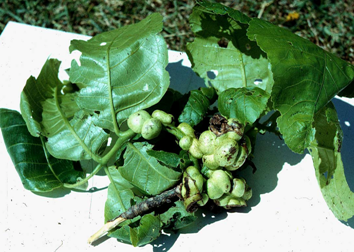
R. Chris Williamson, UW Turf and Ornamental Specialist, UW-Extension
Revised: 8/6/2012
Item number: XHT1024
Galls are abnormal growths on plants that can result from the feeding of living organisms such as bacteria, fungi, nematodes, insects and mites. There are numerous galls that are caused by insects, the most common of which, in Wisconsin, are ash flower gall (see University of Wisconsin Garden Facts XHT1048), hackberry leaf gall, hickory pouch gall, horned and gouty oak galls, and maple bladder gall. Gall formation often disfigures twigs and foliage leading to aesthetic damage, but rarely affects the health or vigor of host plants. However, some galls (e.g., horned and gouty oak galls) can cause serious injury to oak trees.
For most of their lives, gall-making insects live inside gall tissue, sheltered from insecticide sprays. Consequently, timing of pesticide applications for their control is difficult. Furthermore, gall-making insects are difficult to treat with insecticides on taller trees. Yet, because galls are conspicuous, gall-making insects are easy targets of natural enemies such as predators and parasitoids. Because most galls do not kill trees, the best management approach simply is to tolerate their presence.
Hackberry Leaf Gall:
Many of the galls on hackberry leaves are induced by psyllids or jumping plant lice. Adult pysllids look like miniature cicadas. In the fall, the adults leave the galls seeking places to hibernate, often invading homes. Control: Remove and destroy old galls before eggs hatch in the spring. Dormant oil sprays may help reduce a hackberry gall problem. However no insecticide treatment is necessary because the galls will not harm the tree.
Hickory Pouch Gall:
Many hickory galls are caused by the feeding of aphid-like insects called phylloxera. One species produces pouch-like growths on twigs and leaves. Severely infested foliage often turns a yellow-brown color and drops from the tree. The pouches open and phylloxera leave the galls in early summer to continue their life cycle. This insect overwinters as eggs in crevices of old galls. Control: Remove and destroy old galls before eggs hatch in the spring.
Oak Galls
There are two wasp species that induce trees to produce large numbers of horned and hornless galls up to two inches long around stems of oak trees. These gall formations girdle stems and can cause substantial branch dieback. In late spring, adult female wasps emerge from stem galls to lay eggs in oak leaves. The eggs hatch and larvae begin feeding along the leaf veins and subsequently the tree produces blister-like galls. By mid-summer, the adults fly from leaf galls to lay eggs in twigs. Eggs hatch inside the twigs and larvae start feeding and developing. Galls begin to form on twigs soon thereafter. Larvae remain in twigs for two to three years until adults emerge. Control: No control methods have provided satisfactory control of this gall-making insect. However, because severe injury can be caused by this insect, removal of all twig galls in the first winter that they are visible is recommended.
Maple Bladder Gall
Wart-like growths on the foliage of silver or soft maple trees are caused by tiny, maple bladder gall mites. These mites overwinter in cracks and crevices of the bark, and as buds swell and break in the spring, they migrate out to the bud scales. As the buds open, the mites feed on newly developing leaves. The leaves respond to this feeding by developing hollow galls in which the mites live, feed, and mate. These growths are first red, then turn green and eventually black. Galls occur singly or in clusters, and can cause the leaves to become deformed and to drop early. Once formed, galls cannot be removed from the leaves. In the fall, mites move back to the bark where they overwinter. Many homeowners are alarmed when they notice maple bladder gall infestations, fearing that their trees will die. However, trees are unlikely to experience serious injury from these galls, and the trees’ overall health and vigor is not likely to be adversely affected. However, the galls do reduce the aesthetic quality of the tree. Control: No insecticide treatment is necessary, because the galls will not harm the tree.
Additional Images
Download Article

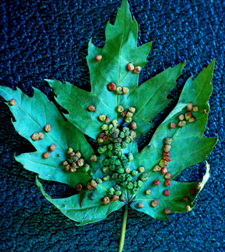




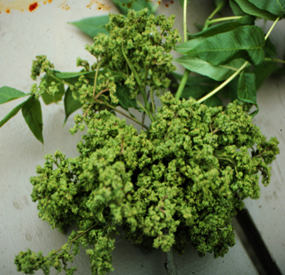 Ash Flower Gall
Ash Flower Gall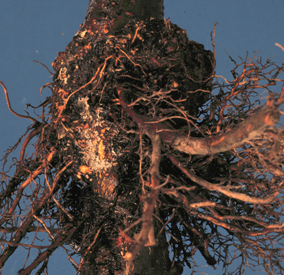 Crown Gall
Crown Gall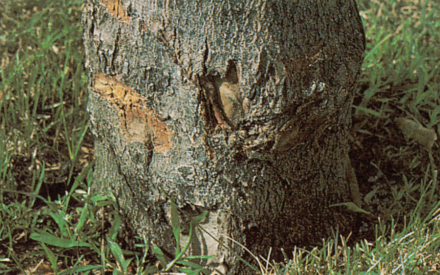 Deciduous Trees Disorder: Miscellaneous Causes of Decline
Deciduous Trees Disorder: Miscellaneous Causes of Decline Shade Trees Disorder: Decline, Dieback, or Early Senescence
Shade Trees Disorder: Decline, Dieback, or Early Senescence


